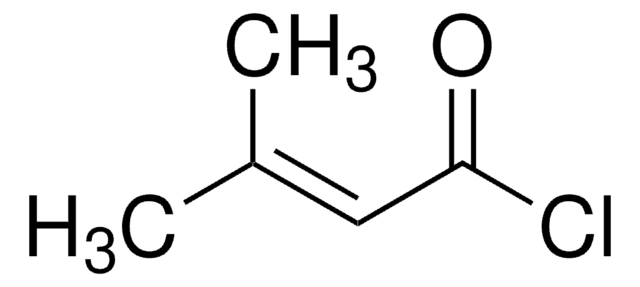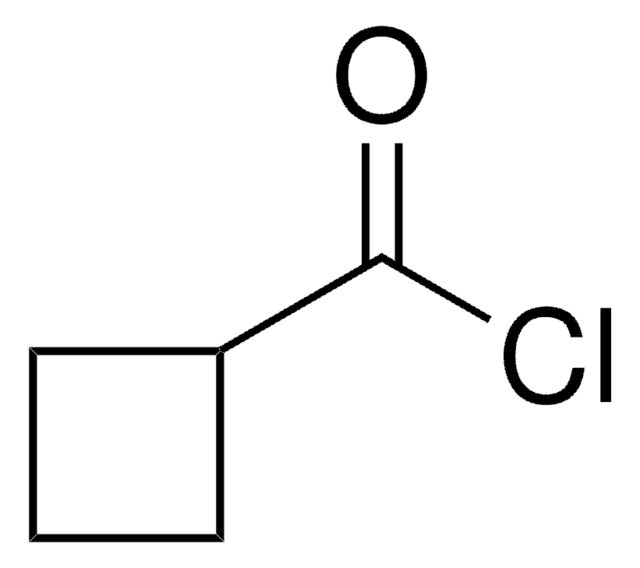추천 제품
Quality Level
분석
98%
refractive index
n20/D 1.416 (lit.)
bp
115-117 °C (lit.)
density
0.989 g/mL at 25 °C (lit.)
작용기
acyl chloride
SMILES string
CC(C)CC(Cl)=O
InChI
1S/C5H9ClO/c1-4(2)3-5(6)7/h4H,3H2,1-2H3
InChI key
ISULZYQDGYXDFW-UHFFFAOYSA-N
유사한 제품을 찾으십니까? 방문 제품 비교 안내
애플리케이션
Isovaleryl chloride was used in the synthesis of:
- furanodictines A and B
- tetrapeptide amide, S-benzyl-L-cysteinyl-L-prolyl-L-leucylglycinamide
- (+)-blastmycinone
- (R)- and (S)-2-methyl-4-octanol, aggregation pheromone of some sugarcane weevils
신호어
Danger
유해 및 위험 성명서
Hazard Classifications
Acute Tox. 3 Inhalation - Flam. Liq. 3 - Skin Corr. 1B
Storage Class Code
3 - Flammable liquids
WGK
WGK 3
Flash Point (°F)
87.8 °F - closed cup
Flash Point (°C)
31 °C - closed cup
개인 보호 장비
Faceshields, Gloves, Goggles, type ABEK (EN14387) respirator filter
이미 열람한 고객
Makoto Ogata et al.
Carbohydrate research, 345(2), 230-234 (2009-12-08)
A novel synthesis of furanodictines A [2-acetamido-3,6-anhydro-2-deoxy-5-O-isovaleryl-D-glucofuranose (1)] and B [2-acetamido-3,6-anhydro-2-deoxy-5-O-isovaleryl-D-mannofuranose (2)] is described starting from 2-acetamido-2-deoxy-D-glucose (GlcNAc). The synthetic protocol is based on deriving the epimeric bicyclic 3,6-anhydro sugars [2-acetamido-3,6-anhydro-2-deoxy-D-glucofuranose (4) and 2-acetamido-3,6-anhydro-2-deoxy-D-mannofuranose (5)] from GlcNAc. Reaction with borate
The Synthesis of the Tetrapeptide Amide S-Benzyl-L-cysteinyl-L-prolyl-L-leucylglycinamide
Ressler Cand Vincent du Vigneaud.
Journal of the American Chemical Society, 76(12), 3107-3109 (1954)
Organoaluminium induced ring-opening of epoxypyranosides. V. Formal total synthesis of antimycin A3 and synthesis of (+)-blastmycinone.
Inghardt T and Frejd T.
Tetrahedron, 47(32), 6483-6492 (1991)
Enantioselective synthesis of (R)-and (S)-2-methyl-4-octanol, the male-produced aggregation pheromone of Curculionidae species.
Baraldi PT, et al.
Tetrahedron Asymmetry, 13(6), 621-624 (2002)
Jessica L Wojtaszek et al.
Cell, 178(1), 152-159 (2019-06-11)
Intrinsic and acquired drug resistance and induction of secondary malignancies limit successful chemotherapy. Because mutagenic translesion synthesis (TLS) contributes to chemoresistance as well as treatment-induced mutations, targeting TLS is an attractive avenue for improving chemotherapeutics. However, development of small molecules with
자사의 과학자팀은 생명 과학, 재료 과학, 화학 합성, 크로마토그래피, 분석 및 기타 많은 영역을 포함한 모든 과학 분야에 경험이 있습니다..
고객지원팀으로 연락바랍니다.















